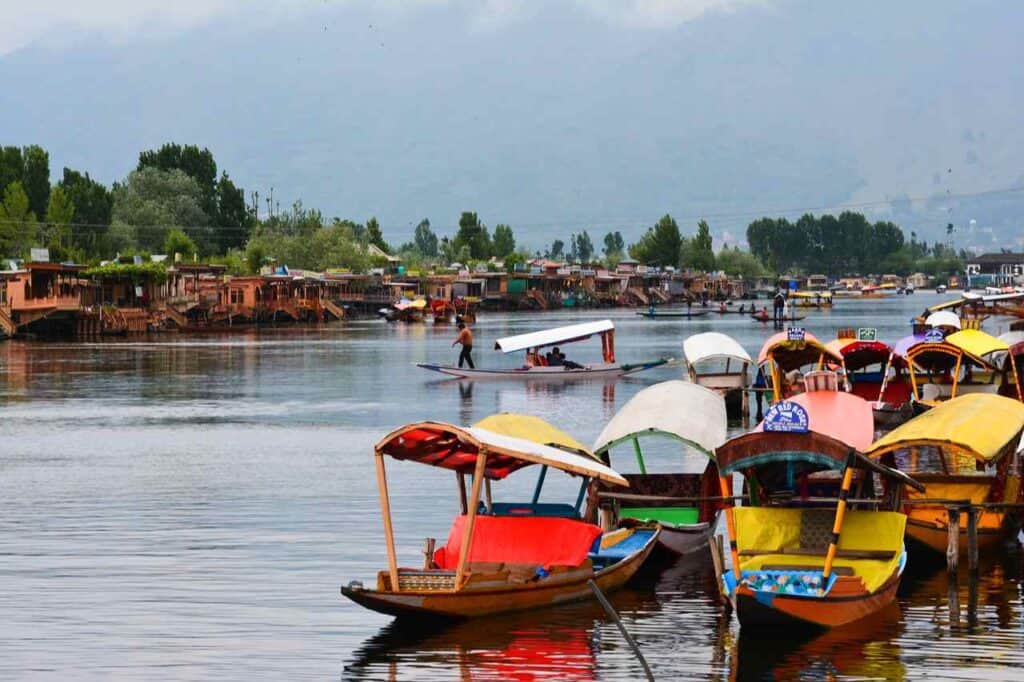Srinagar is the summer capital of the northernmost state, Jammu & Kashmir. Besides being one of the most stunning cities of India, its location in the Kashmir valley, a disputed area between India and Pakistan, keeps the visitors periodically or permanently away. Kashmir is eager to rebuild its reputation and attract tourists who preferred the safe Buddhist Ladakh region until now. But the city of lakes and gardens, once the favorite of Emperors and the British, has plenty of things to offer. In this guide, you will find all the information about the best places to visit and things to do in Srinagar.
What is Srinagar like?
Srinagar is the summer capital of Jammu and Kashmir State (J&K) and the biggest city of the Kashmir valley with a population of 1.2 million. Every year from November till April the capital shifts to Jammu, the other major city in the state. Gulab Singh maharaja started the tradition, called “Durbar move” in 1872 and despite opposition, the practice still persists.
If you combine your Kashmir trip Ladakh read this article about the best two-week itinerary
Srinagar offers plenty of things to do and places to visit. It has a stunning location amid snow-capped mountains almost all year round. But first and foremost, Srinagar is the city of lakes, charming Islamic gardens and mosques. The Dal and Nagin lakes are essential scenes of Kashmiri life with houseboats, gardens and shops built on the water.
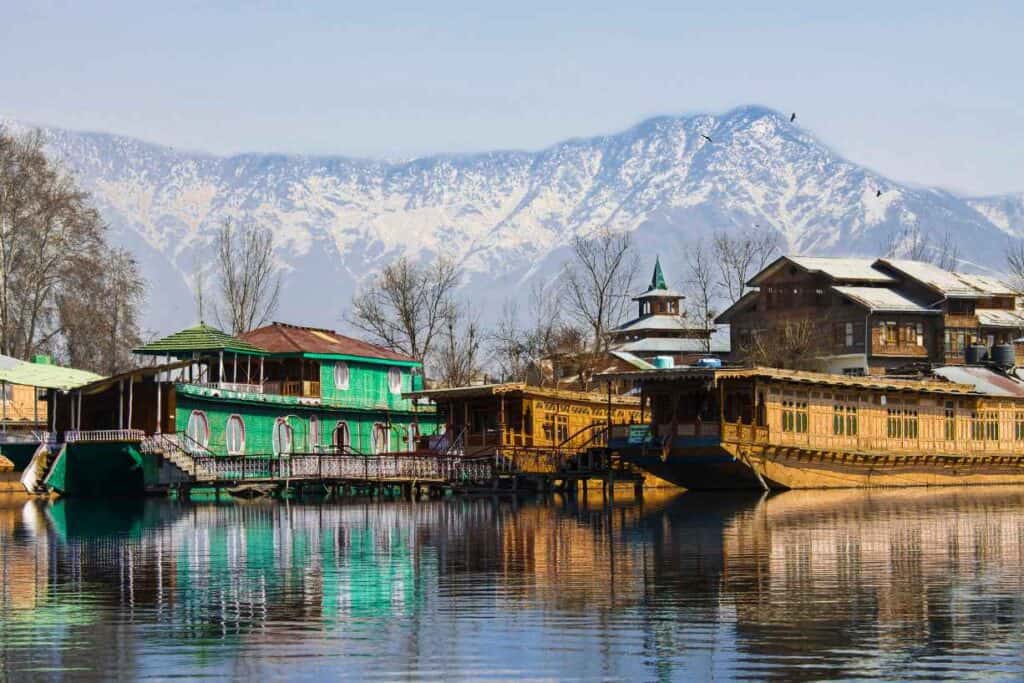
There are two hills inside the town: The Hari Parbat, with an 18th-century fortress on its summit and the larger Shankaracharya hill topped by a Hindu temple. Both are great spots to enjoy the best panorama of the city.
The Jhelum, the main river of the Kashmir valley crosses the old town of Srinagar. On either side a range of traditional wooden houses stretch out. These are one of the oldest buildings in Kashmir. Nine attractive bridges connect the two sides of the river.
The clean and lush green Kashmir valley between the Pir Panjal and Himalaya ranges could also be placed the in the Alps with its expansive pine forests, crystal-clear waters and 4000-5000-meter-high mountains. However, when you are approaching Srinagar and leave the immaculate nature, it gets filthier and crowded.
There is a big security presence in the whole Kashmir valley, especially in Srinagar due to the Indian-Pakistan conflict over the Kashmir valley. Here, around 97% of the population are Muslims. The rest are the so-called Hindu pandits. Many Hindus come to Srinagar during the Amarnath Yatra pilgrimage (July and August).
What is the best time to go to Srinagar?
You can visit Srinagar any time of the year. The monsoon does not affect the Kashmir valley, because the Himalaya ranges block the monsoon clouds. Of course, it does not mean that Kashmir is dry, but it is gradually raining throughout the year. Since the valley is a plateau at 1400-1500 meters the heat is bearable even in the summer. The best time for a cultural visit and trekking in Kashmir is between April and October. Even in summer, the weather is pleasant.
If you combine your visit to Kashmir with Ladakh, where the temperature sharply drops during winter, then June-September is the best time for your visit.
Pin it for later!
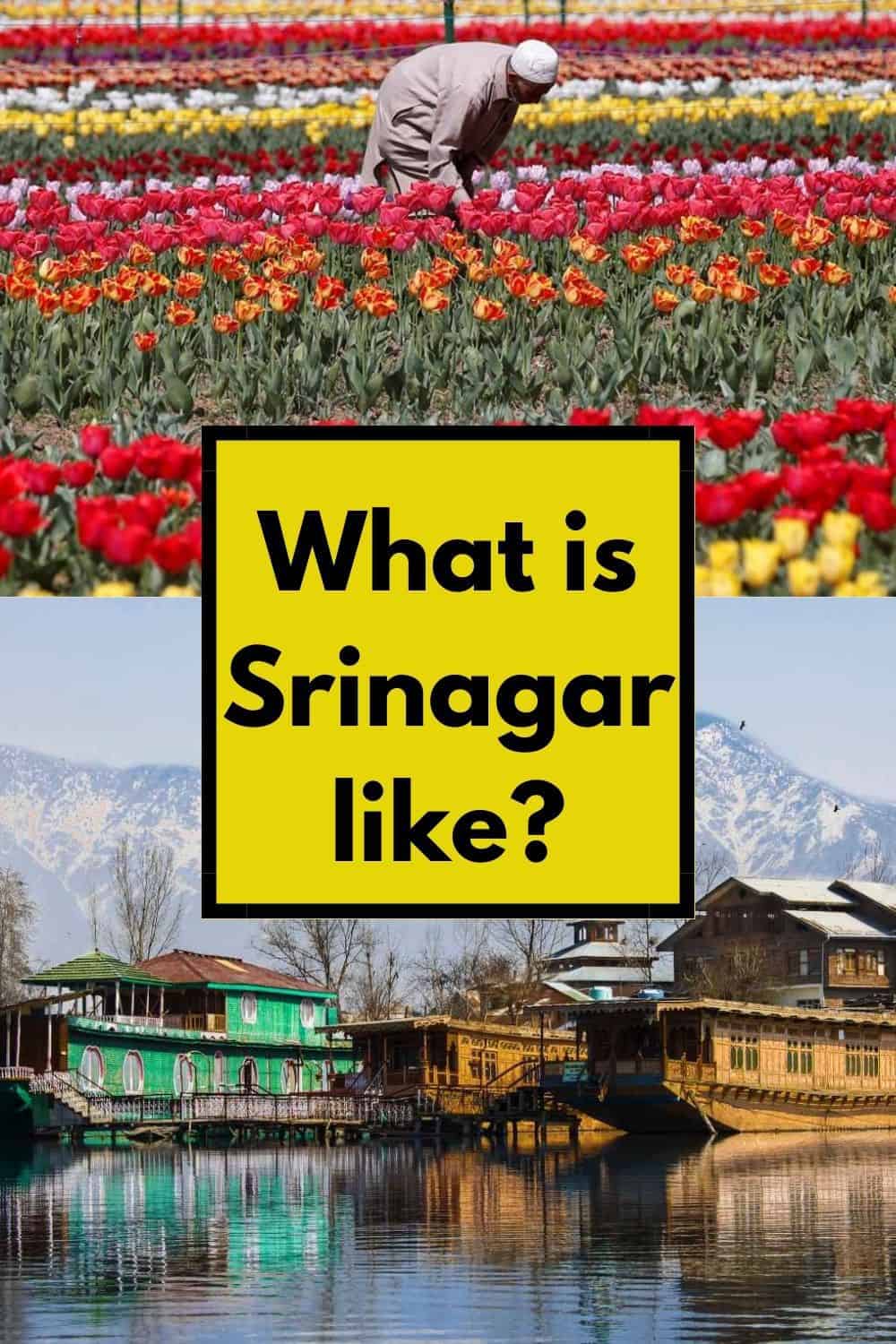
How to go to Srinagar from Delhi?
Flight: Srinagar has a flight connection with some major Indian cities: Jammu (45min), Leh (50min), Mumbai (2h45min), Chandigarh (1h 20min) and Delhi (1h 15 min). Air India, Indigo, GoAir, Spice Jet and Vistara Air operate flights to Srinagar.
Flight/train + road: Your other option is to take a flight or a train to Jammu and then an approximately 8-9 hours long bus ride to Srinagar. The railway extension till Srinagar is under construction and is expected to be ready in 2022.
Costs of a private taxi: 3000 – 5000 INR for a private taxi
Cost of a shared taxi or jeep: 400-500 INR
Cost of public bus: Depending on the class you take (A, B or C) 200-500 INR.
Road: If you arrive from Ladakh, it takes two days from Leh to drive to Srinagar with a one-night stop in Kargil.
The best places to visit and things to do in Srinagar
1. Stay for the night in a houseboat, “the treasure of Srinagar”
To stay in houseboats on the Dal or Nagin lakes is one highlight of your visit. The lakes are an essential scene of Kashmiri life. Even pharmacies, post offices, and shops are built on the lake. Roughly 1200 houseboats are moored on Dal and Nagin Lakes and along the Jhelum River in town.
The only way to reach your houseboat is with „Shikaras” (small boats). Six people can sit in a Shikara made of the resistant cedar tree. The covered ones transport the tourists, the others are used for fishing, harvesting and transport. Some of them are still the homes of poor people.
Houseboats and Shikaras are the symbols of Kashmir.
The houseboats are often elaborate single-storey, narrow barge-like vessels crafted out of cedarwood. Unlike those in Kerala, these are often more attractive and do not move. They are moored right next to each other, with the boat next door just a few meters away.
The best two-week Ladakh and Kashmir itinerary
Under British rule between 1858 and 1947, the Britons flocked to Kashmir’s lakes for summer holidays to escape the scorching heat of the region further south. At that time, foreigners were not allowed to own land or anything anywhere in India. So the British built houseboats to evade the law. And it worked. Because the boats were not on land, they did not count as property. Many of today’s houseboats are originals, built in the colonial era. But even the newer boats have the old style as the builders like to follow the tradition.
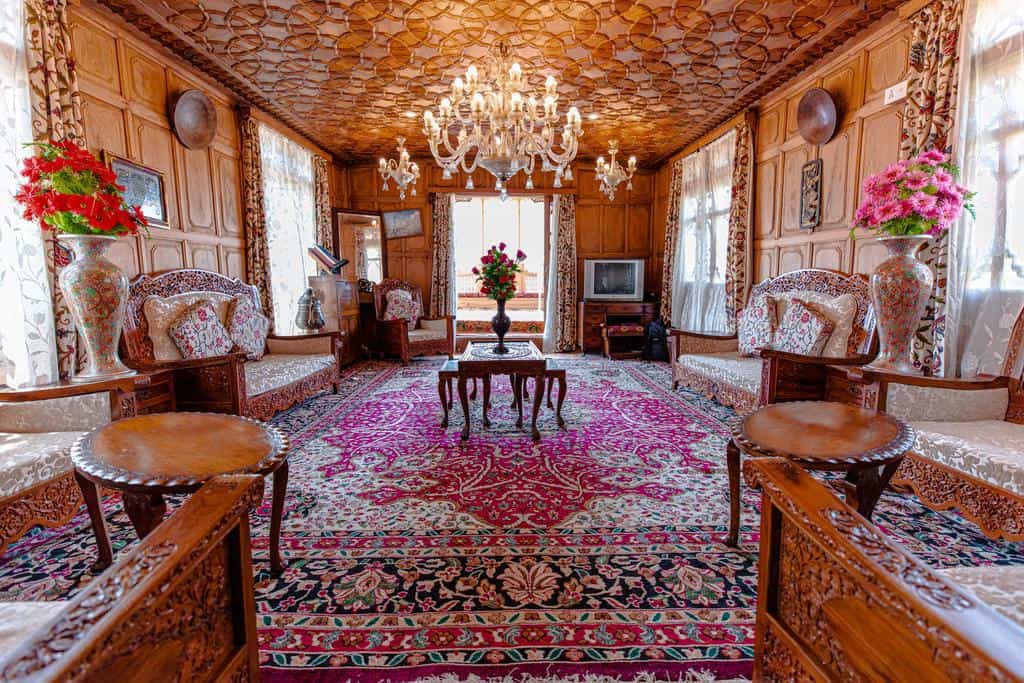
But it was not the British who first came up with the idea to live on the water. Many Kashmiris lived on “Doongas” earlier—a long narrow craft with accommodation and cultivated their gardens from the boat. These Doongas were padding around Kashmir’s waterways since time immemorial. The houseboat was only a more sophisticated and solid version of the traditional Kashmiri boat.
The Dal lake is an excellent place for water sports lovers, with waterskiing, surfing, and canoeing and probably the best place to visit in Srinagar.
Attention: The sellers are on the lurk to paddle after your Shikara and push you to buy something. It can be pretty annoying but try to keep calm. If you are not interested, do not look at the products. If the sellers see you are uninterested, they will leave you alone. Well, it still takes some time for them to realize it.
One more important thing is that you always have to bargain!
2. Take a Shikara ride on the Dal lake
Take a boat ride on Dal Lake to see the Kashmiri life on the water. Shops selling the intricate wood carvings, Pashmina shawls, papier-mâché boxes, spices, and all the famous products of Kashmir stand on stilts. Tell your boatmen to stop at the shop where you want to have a closer look, and get into the boat when you finished.
Check the incredible lotus and vegetable gardens also floating on the lake. The Kashmiris separate the farmland from the ground and anchor it in the water. The gardens are particularly colorful when the flowers blossom in July and August.
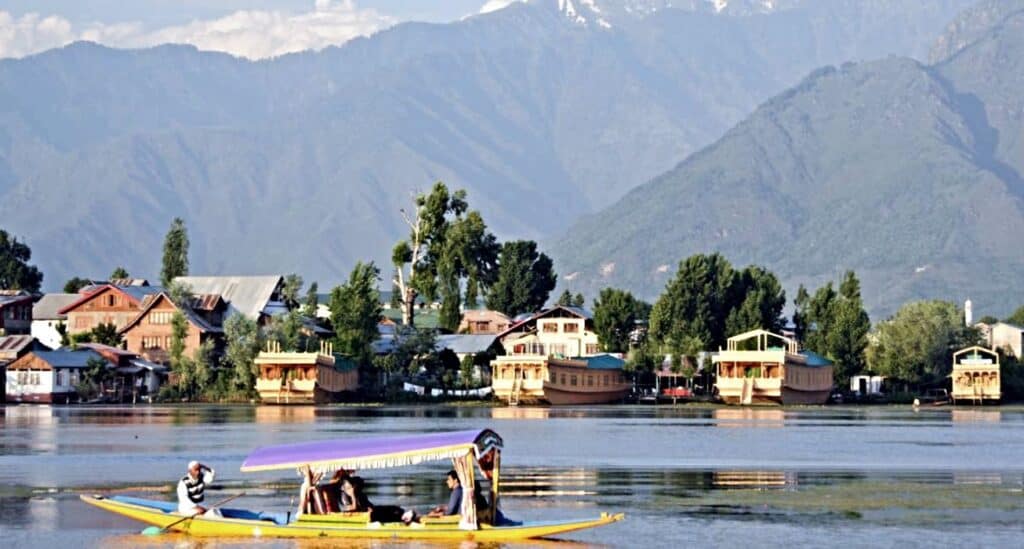
During summer it is better to take the two hours-long rides in the evening, but do not forget to use mosquito repellent and wear light long trousers with long-sleeved- shirts.
The cost of a Shikara boat ride: 300- 400 INR for 1 hour in the off-season and 600-700 INR in the high season. There are no fixed prices, which means you have to bargain.
3. Enjoy the sunset view from the Hari Parbat fort
You can spot the Hari Parbat Fort from several points of the city. The current structure was built by the Afghans when Kashmir was a part of the Afghan Durrani Empire. Currently, the security forces use the fort, and it is closed to the public. But the view is incredible. The shrines of three religions occupy the hillside: Shrine of Makhdoom Sahib, a saint held in great reverence by the Kashmiri Muslims, the Sharika Devi Mandir, a sacred place for Hindus, and the Chatti Padshahi Gurudwara where the Sikh believe that Guru Hargobind preached.
4. Visit the early morning floating vegetable market – the second-largest wholesale market in the world
You should not miss the floating vegetable market (Sabzi Bazar) on the Dal lake early morning. The sellers paddle their boats to the middle of the lake at 4 am. It is fantastic to see as the business evolves in the morning mist with tons of fresh vegetables all grown in the floating gardens of Dal lake. They exchange all products from the shikaras, and even the cold winter does not keep them away from the long tradition. In two and a half hours everything is over, and the shikaras paddle away in different directions. Observing the floating market is one of the best experiences in Srinagar.
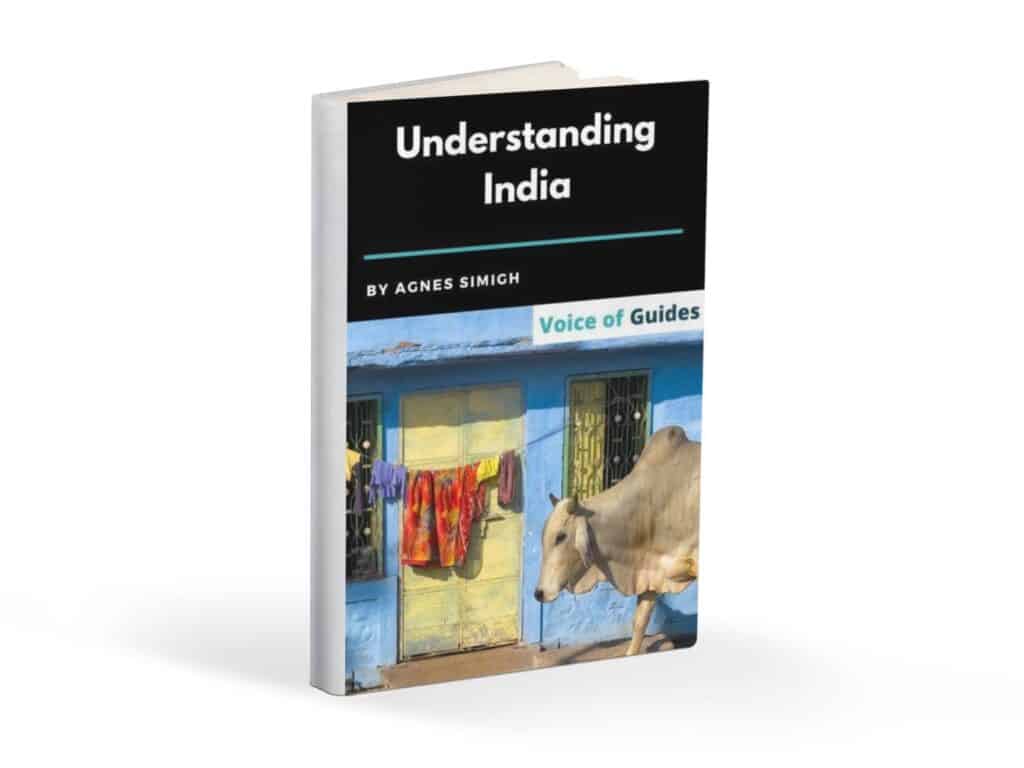
5. Stroll around the Mughal gardens – the places you must visit in Srinagar
The Mughal Emperors, especially Jahangir, adored the Kashmir valley and Srinagar. They used it as a summer retreat and created amazing Islamic gardens. Although they lost their original beauty, they are still pleasant to stroll around.
There are four Mughal gardens: the Pari Mahal, Chashma-i Shahi, Shalimar Bagh, and Nishat Bagh. Most tourists visit the latter two along Dal Lake.
The best two-week Ladakh and Kashmir itinerary
Pari Mahal
It was a place of learning and religious debates and probably an observatory as well. Shah Jahan’s (the Mughal Emperor who built the Taj Mahal) eldest son, Darah Shikoh, ordered to construct it. It is worth going up for the stunning views of Dal Lake and Srinagar. He was a gentle, studious man who loved nature and art, like his grandfather Jahangir. He shared Jahangir’s love for Kashmir too.
Opening hours: 9:30 am – 5:30 pm
Entrance fee: 10 INR
Chashma-i Shahi
Shah Jahan did not share his father’s passion for Kashmir, possibly because he was more Indian than Jahangir. Though he visited Kashmir only four times after his accession, Shah Jahan did not neglect the valley and built the prettiest garden around the Dal Lake, the Chashma Shahi, on three levels. It is along the road up to Pari Mahal. At the backside, there is a natural spring.
Opening hours: 9 am – 7 pm, except Monday
Entrance fee: 10 INR
Shalimar Bagh (Bagh means garden) – the most beautiful garden in Srinagar
Earlier, they approached Shalimar from the water. But the road that now circles the Dal lake has spoiled the original entrance to the garden. Emperor Jahangir constructed it for his favorite wife, Nur Jahan.
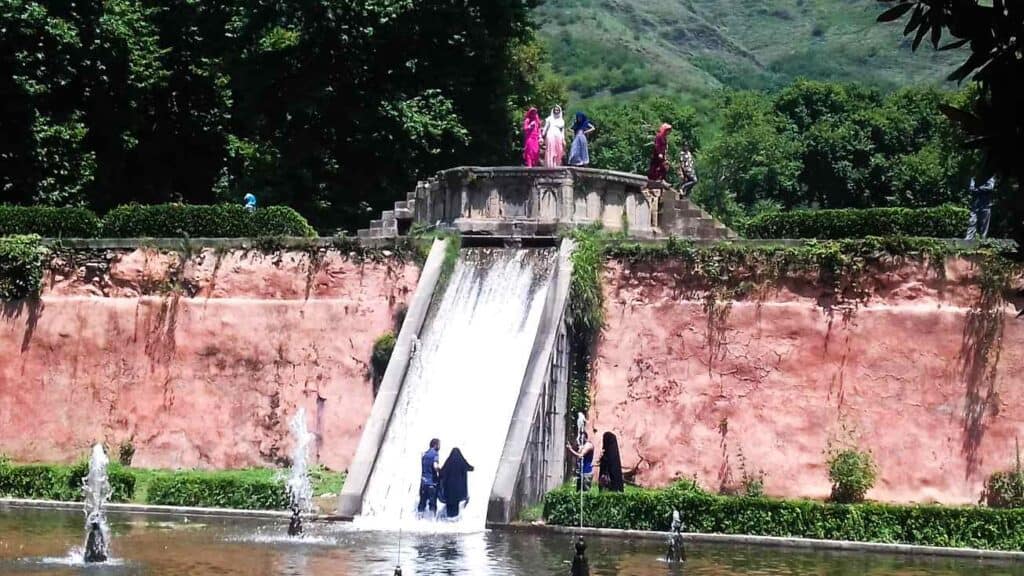
It is a perfect example of an Islamic garden divided into four symmetrical parts. It has three levels. On the second level stands the Diwan-i Am, a public audience hall, where the Emperor would appear to his subjects. The centerpiece of the garden is the black marble pavilion surrounded by a water basin with fountains. It was the “zenana”, the part reserved for the royal ladies. The remains of the wall prove that it was separated from the rest to hide the royal ladies.
Opening hours: 9 am – 7 pm
Entrance fee: 10 INR
Nishat Bagh
The second largest after Shalimar Bagh, “the garden of pleasure”. Unusual to an Islamic garden, it has a circular shape because they had to adjust it to the geographical conditions. There is a large pool with fountains at the top. This upper portion was designed for the women of the imperial family, and once there were several pavilions here. The brother of Nur Jahan, Asif Khan, built it in the 17th century. It means that this did not belong to a Mughal emperor but to a noble person. For that, it had only two parts, and the part for the royal ladies is missing.
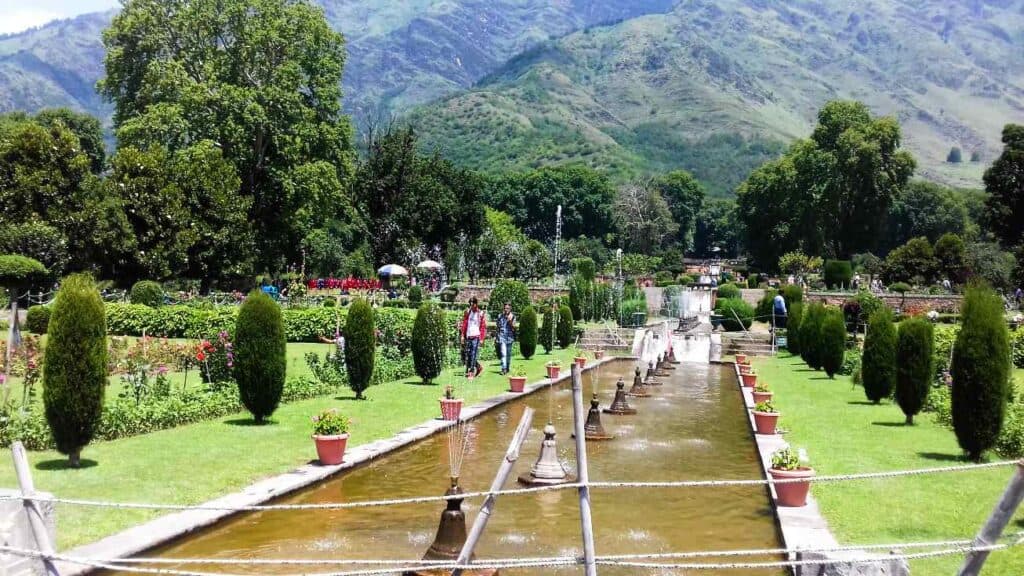
On hot summer days, Kashmiri children play in the water, while the parents have a picnic in the shadow. The gardens are perfect places to meet the locals.
Opening hours: 9 am – 7 pm
Entrance fee: 10 INR
6. Visit the Siraj Bagh during the Tulip Festival
Somewhere between March and May, Siraj Bagh, or nowadays called the Indira Gandhi Memorial Garden gives home to the largest Tulip Festival in Asia. The 1.5 million tulips and daffodils of different colors are perfectly aligned on over 30 hectares. The exact date of the two-week-long festival depends on the blossoming.
Opening hours: 7 am- 7:30 pm
Entrance fee: 50 INR
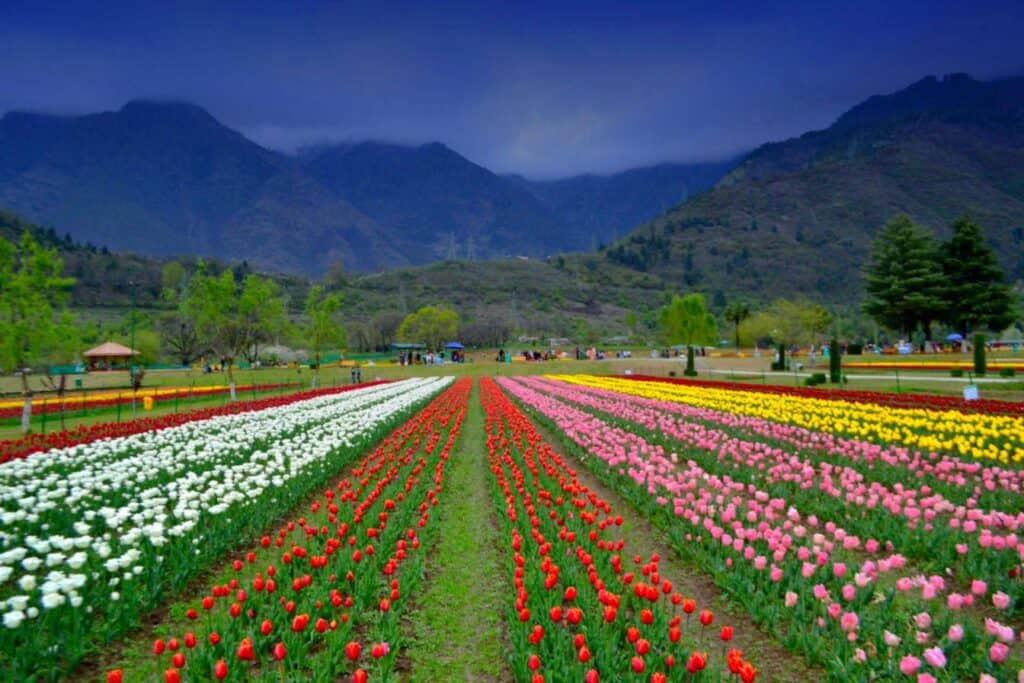
7. Climb up to the Shankaracharya Hindu temple
The small temple on top of the forested hill is one place you must visit in Srinagar. Cars are allowed until a certain point, but there are still 243 steps left till the top.
The current temple is dedicated to Shiva but named after Adi Shankaracharya, a 9th-century Hindu philosopher-saint who visited Kashmir. After the Mughals, they stopped using it as a temple for centuries. But in the 19th century, it was renovated, and they installed a Shiva lingam. In 1961, the statue of the Hindu saint was added to the complex. The temple gets overcrowded during the Hindu pilgrimage, the Amarnath Yantra.
It is also worth climbing the stairs for the incredible view of Dal Lake and the Jhelum river if you are not interested in the temple.
Important: Remove your shoes before you enter the temple.
Opening hours: 8 am- 5 pm
Entrance fee: free of cost
8. Visit the most famous mosques in Srinagar
Jama Masjid
The Jama masjid has a typical Kashmiri-style roof with pagoda-like towers. The columns, the ceiling, the beams, and the Jaali-style windows at the back of the prayer hall are all constructed out of wood. Each column is made from the trunk of a single deodar tree. The 15th-century mosque can accommodate more than 30.000 people. Each prayer place is marked with special rugs and carpets.
Opening hours: 3 pm – 7 pm
Entrance fee: free of cost
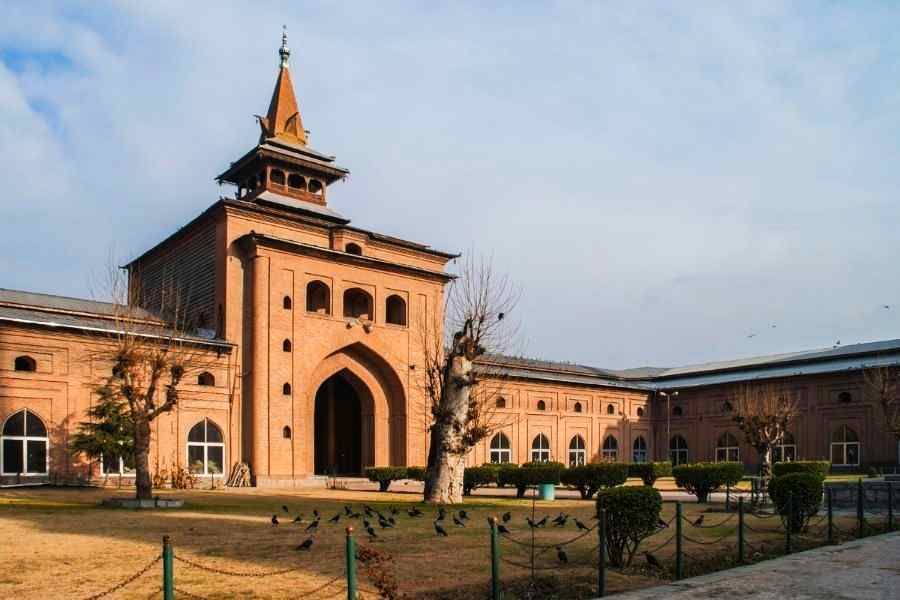
Hazratbal mosque – Kashmir’s holiest Muslim shrine
The mosque is a modern-style white marble building that contains a single strand of the Prophet Muhammad’s hair. It stands on the side of Dal Lake, 3km northeast of Hari Parbat. The hair is inside a glass phial usually kept in a small room above the mihrab (the niche that indicates the direction of Mecca and praying). In the 1960s, the hair was stolen, prompting large-scale demonstrations across the valley. The hair reappeared just as mysteriously as it had vanished.
Opening hours: 9:30 am- 5:30 pm
Entrance fee: free of cost
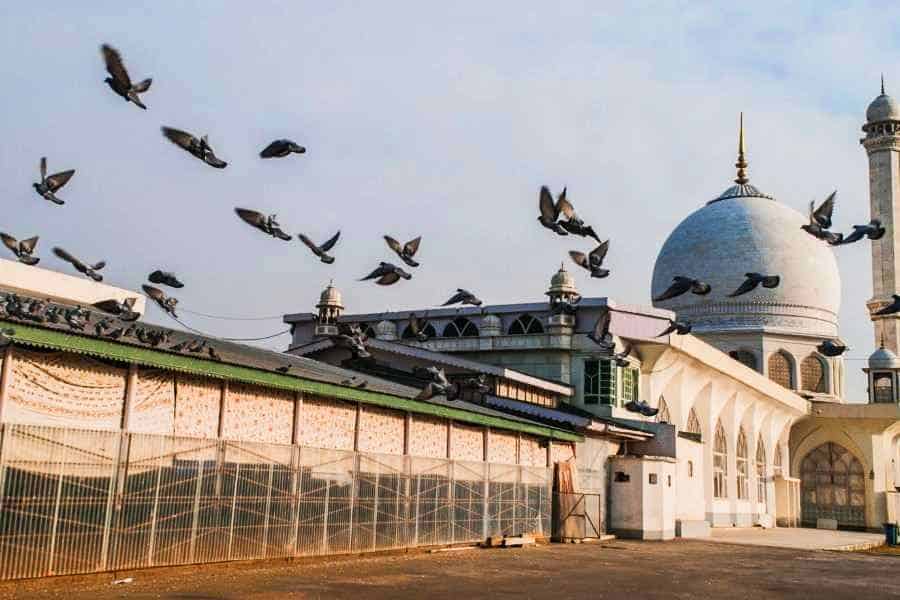
Shah Hamadan Mosque – the oldest mosque in Srinagar
The old town opens up from the mosque and stretches on both sides of the Jhelum River. Amid the eighteenth and nineteenth-century wooden buildings stands the Shah Hamadan, the oldest mosque in Srinagar. The green pagoda-like tower that strikes out of the green roof is a typical Kashmiri architectural element. The mosque, entirely built out of wood, honors the Persian saint Mir Sayyid Ali Hamadani, one of the first Islamic preachers who traveled to the valley and peacefully converted the region to Islamic mysticism in the fourteenth century. It served both as a prayer hall and a meeting hall. After a devastating fire, it was rebuilt in the 1730s without using any nails.
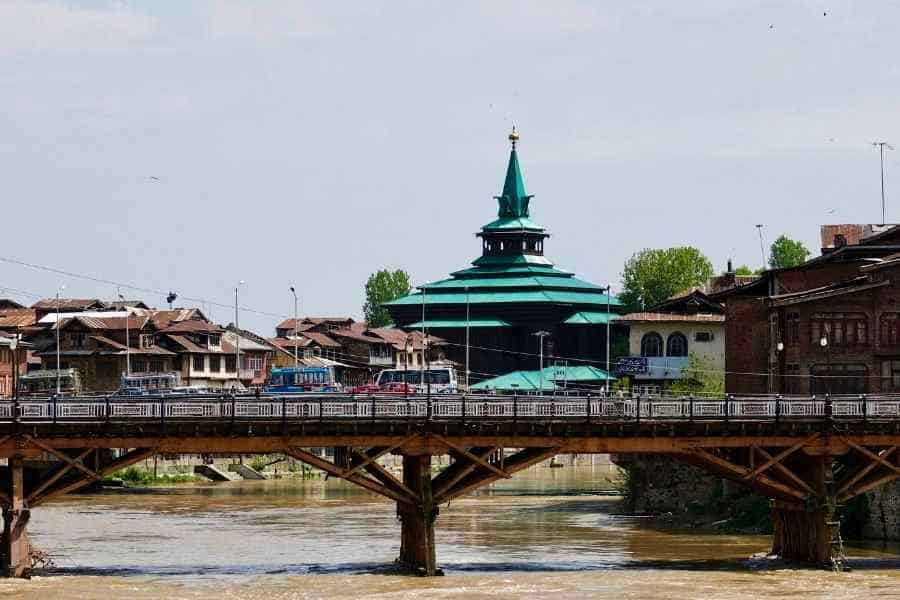
The European chandeliers, stained glass windows, colorful lacquered papier-mâché covered columns and painted walls make the interior decoration unique.
Location: 700 m from the Jama Masjid
Opening hours: 9:30 am – 5:30 pm
Entrance fee: free
The best two-week Ladakh and Kashmir itinerary
Rozabal Mosque and Shrine – the tomb of Jesus?
This small building officially contains the tomb of Youza Asouph, a Muslim saint, but it is also known as the Tomb of Jesus. But how come that Jesus is buried in Srinagar?
The legend is that he was taken down from the cross by friends while he was still alive and smuggled out of Jerusalem, then lived in Kashmir till the age of 80 when he died. The most likely explanation for the story is that the tomb at Rozabal was the burial place of a foreigner, perhaps one of the Middle-Eastern ambassadors to Zain-ul-Abidin’s court. His name might have sounded something like ‘Jesus’ so that over the centuries, this confusion—and wishful thinking—turned the site into ‘Jesus’ tomb’.
Opening hours: 9:30 am- 5:30 pm
Entrance fee: free of cost
Recommended tours from Srinagar
1. Kashmir Great lakes trek
This 6-day trekking starts from Sonmarg to Naranag via Nichnai Pass. The Great Lakes, as the name suggests, passes through many high altitude alpine lakes situated at the foothills of different snow-clad mountain peaks. The most famous lakes are Vishansar and Gangabal Lakes. It crosses streams, plenty of colorful alpine meadows, and ascends three mountain passes with an average altitude of 4000 m above sea level. The highest mountain peak which dominates the second part of the Trek, is Mount Haramukh standing at 5300 meters above sea level.
Book your tour here.
2. Visit the famous gardens of Srinagar
The stunning Mughal gardens are one of the landmarks of Srinagar. During this tour, you can visit the Shalimar Bag, Nishat Bagh, the Chashma-i Shahi and the tulip garden.
3. Have a day trip to Gulmarg
4. Go on a 5-day private tour including Srinagar, Gulmarg, Sonamarg and Pahalgam
Find more information about the tour here.
Recommended houseboats in Srinagar
Mascot Houseboat– 5* Nagin Lake
Welcome Heritage Gurkha – 4* Nagin Lake
Wangnoo Heritage – 3* Nagin Lake
Kolu Houseboats – 3* Dal Lake
Meena Houseboats – 3* Dal Lake
Recommended hotels in Srinagar
Lalit The Grand Palace – 5*
Vivanta Dal View – 5*
Radisson – 5*
The Orchard Retreat & Spa – 5*
Royal Batoo–4*
Clarks Inn – 4*
Hotel Welcome – 3*
Hotel Shah Abbas – 3*
Recommended restaurants in Srinagar
Adhoos Restaurant – Local Food
Mughal Darbar – Local Food
Lazeez by the Lake – Multi Cuisine
Shamyana Restaurant – Multi Cuisine
Lhasa – Chinese Food
Chai Jai – Local Café and tea Room
Kareema Restaurant – North Indian
Krishna Dhaba Restaurant – Indian Vegetarian Food
14 Avenue Café & Grill – Western Café
Amigo’s Café – Pizzeria
Srinagar is a unique place in India. The life on the lakes is extraordinary with the floating gardens, stilted houses, shops, and the houseboats anchored. Take a boat ride with a Shikara and head early morning to the vegetable market, where traders exchange all products from the boats.
The best things to do in Ladakh and Kashmir
Stroll around the oldest part of the city and visit some famous mosques built in Kashmiri style. Enjoy the magnificent panorama from the tops of the Hari Parbat or Shankaracharya hill. Finally, you must spend at least a night on a houseboat decorated with fine examples of incredible Kashmiri wood carvings and handwoven carpets. Kashmir kept tourists since the 1990s away, but in the last ten years, it has become a popular destination again. Kashmir is safe, but do not forget to check information about the current state of security.
How to plan your trip to India
Book your flight ticket to India: I always use Google Flights, Skyscanner or Wayaway to find the cheapest flight tickets worldwide. To get an extra 10% for your Wayaway Membership Plus program use my discount code VOG
Insurance to India: Safetywing is an affordable insurance that covers COVID-related issues as well.
: Book your train, bus and domestic ticket in India:
Check Indian Railways website for train tickers, or 12Go which gives you the best option (train, bus, and flight) based on the city of departure or arrival.
Book accommodation in India: Booking.com and Hostelworld.com offer a wide choice of low and higher-budget hotels.
Local tours and tour packages: Viator and GetYourGuide offer transfers and several one or multi-day tours.

